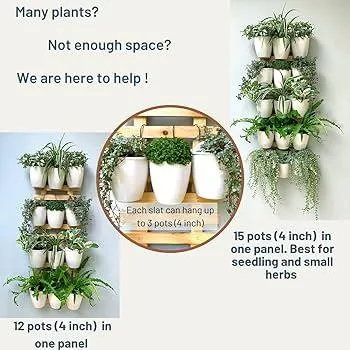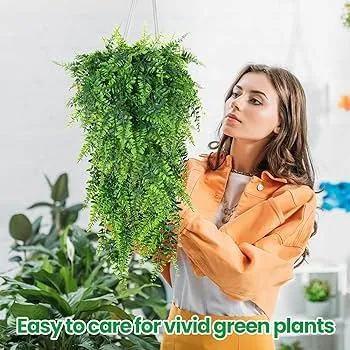Everything You Need to Know About Indoor Hanging Wall Plants
If you’re looking to add some greenery to your home but don’t have much floor space, indoor hanging wall plants are a great option to consider. In this article, I’ll discuss the various types of plants that do well hanging on walls, tips for care and maintenance, and ways to display your plants attractively. By the end, you’ll have all the info you need to transform your walls into a verdant oasis!
Top Choices for Hanging Wall Plants
There are many plant varieties that thrive when planted in hanging baskets or wall planters. Here are some of the most popular:
- Pothos: Also known as devil’s ivy, pothos is one of the easiest indoor plants to care for. It’s very tolerant of low light and infrequent watering. Its heart-shaped leaves come in various colors like green, white, and Variegated.
- Philodendron: Similar to pothos, philodendron does well in average indoor conditions. It has longer leaves and vines that cascade down beautifully when hung. Try heartleaf or brasil philodendron varieties.
- English ivy: With its small dark green leaves and ability to climb high vertically, English ivy makes a splendid hanging plant. It thrives in medium to low light.
- Spider plant: Known for its long grass-like leaves and miniature plantlets that form on its flower stems, spider plants are low maintenance and very forgiving.
- Succulents: Chunky leaved succulents like echeveria, senecio, and kalanchoe are stylish hanging plants that need very little water.
Those are some of the top options, but there are tons of other great hanging plants to experiment with as well!
Tips for Planting and Caring for Hanging Wall Plants
Now that you know which types of plants to use, here are some tips for getting them established and thriving on your walls:

- Use a basket or planter with drainage holes so the soil can dry out between waterings. Terracotta and rattan are popular natural materials.
- Select a spot that gets at least 4 hours of indirect light daily. Most plants listed above tolerate low light well but may grow leggy without enough.
- Use a well-draining potting mix specifically for houseplants. Pack the soil firmly and water thoroughly after planting to get roots started.
- Water when the top inch of soil is dry. For succulents, wait until soil is completely dry. Overwatering is the most common care mistake.
- Hang baskets high enough so leaves and vines can cascade down attractively without pets or children interfering.
- Give plants a boost with a liquid houseplant fertilizer in spring and summer per label directions.
- Prune off any dead or diseased parts occasionally to promote new growth and a full shape.
Follow these tips and your hanging plants should thrive! The key is finding the right balance of light, moisture, and nutrients.
Ideas for Displaying Hanging Wall Plants
Now that you know which plants to choose and how to care for them, here are some creative display ideas to really showcase your hanging plant collection:
- Cluster hanging planters together in a vertical row to create a lush “living wall.” Use varying heights for visual interest.
- Float macrame or jute hangers from rustic metal chains anchored under wall molding or ceiling beams.
- Layer different textured baskets in descending sizes on ceramic wall plate mounts or shepherd’s hook poles outdoors.
- Attach simple branches or small poles across a window and loop jute through drilled holes to hang single pots informally.
- Combine a tiered wooden wall shelf with built-in pot recesses for a designed look.
Get creative with colorful pots, woven hangers, and atmospheric lighting for a wall totally “plant-scaped.” Your plants will thrive in their artful new home!
Challenges You May Encounter
While hanging plants are low maintenance overall, there are a couple issues you may have to overcome:

- Pothos and philodendron can be prone to spider mites in dry indoor air. Regularly check under leaves and treat with insecticidal soap if spots appear.
- If space is cramped, vines and trails may intertwine over time and crowd each other out. Careful pruning keeps plants shapely.
- Tall hanging pots without saucers can drip water onto surfaces below when watered. Placing trays underneath helps prevent damage.
- Strong drafts or cold temperatures may cause leaf browning, especially on succulents. Sheltered spots away from vents provide more stable conditions.
With a little preventive care and quick solutions to potential mildews, pests or other minor issues, your indoor hanging plant collection should thrive for years!
Frequently Asked Questions
Here are answers to some additional common questions:
- How do I start plants from cuttings? Most vines like pothos root easily in water. Trim 4-6″ stems, remove leaves from bottom half, and place upright in a container. Roots will form in 1-3 weeks.
- Are any hanging plants toxic to pets? Lilies, tulips, aloe and some succulents can cause gastrointestinal upset if ingested. Keep them high or in closed planters if pets are about.
- What’s the best way to water? Use a waterspout attachment on your faucet or watering can for easy top-down moisture without disturbing the soil. Aim for the center of each planter.
- Can hanging plants be brought indoors in winter? Yes, tropical varieties like pothos and English ivy adapt well with supplemental lighting. Take succulents inside before first frost to avoid cold damage.
I hope this guide has covered all of your questions! Indoor hanging plants are a peaceful, life-giving addition indoors and provide natural decor year-round. Let me know if any other topics come up as you get started with your collection.
Best Indoor Hanging Plants
| Plant | Light Needs | Watering | Size |
|---|---|---|---|
| Pothos | Low | Let dry between waterings | Varies, trailing to 2-3 feet |
| Spider Plant | Low to medium | Let dry slightly between waterings | 1-3 feet tall and wide |
| Philodendron | Low to bright indirect | Let dry slightly between waterings | Varies by variety, up to 6 feet tall |
| Peperomia | Bright indirect | Let dry slightly between waterings | 4-12 inches tall and wide |
| English Ivy | Low to bright indirect | Let dry slightly between waterings | Vines indefinitely, keep pruned |
FAQ
-
What kind of plants are good for indoor hanging baskets?
There are various plants that basically do well hanging indoors. Common choices are pothos, philodendron, english ivy, and spider plants. These plants sort of need very little care and thrive in low or bright light conditions.

-
How do I care for hanging basket plants?
To look after hanging basket plants, you’ll need to water them regularly but not too much. Around once a week seems to work for most varieties. Be sure the soil is dry about an inch down before watering again. You should also turn the basket occasionally so all sides get light. Every few months, you may have to repot the plants into a larger container if their roots have filled out the basket.
-
What is the best way to hang indoor plants?
There are a few different methods for hanging indoor plants. Macrame hangers are awesome but take some skill to make. Chain or jute rope is perhaps kinda simpler to use with S-hooks or clips attached to them. Some people apparently even hang plants in hanging shelves, chairs or from the ceiling using fishing line so they appear to be floating! Kinda cool but I wouldn’t want to be under one if it fell.
-
How do I know if my hanging basket plant needs fertilizer?
Signs that a hanging basket plant may need fertilizer include buds or flowers that fail to develop fully, and leaves looking a bit pale or small. You can try fertilizing in the spring when new growth starts, and every few months after that during the growing season. Be sure not to overdo it though, as too much fertilizer can apparently “burn” the roots. Mild, all-purpose liquid fertilizers seem to work well for most common indoor hanging plants based on what experts say.
-
Can indoor hanging plants improve air quality?
Some studies show that certain plants may help clean the air inside homes and offices to some extent. Spider plants, peace lilies and English ivy are reported to be amazing at removing toxins like formaldehyde, benzene and trichloroethylene from the air. So it makes sense that hanging baskets of these varieties could assist with freshening up stagnant indoor air. But is it enough of a difference to truly impact someone’s health? Perhaps more research is still needed on that.

-
What if my hanging basket plant gets infested with pests?
If you notice any tiny insects like spider mites or gnats swarming one of the plants, act quickly before it spreads. Isolate the infested plant from others as a start. You can try spraying the leaves and soil with a mix of water and dish soap to drown the pests. As a last resort, there are chemical pesticides for problem insects. But I’d exhaust the natural remedies first if possible before resorting to those. Prevention is apparently always better than cure when it comes to plant pests.
-
Are hanging basket plants challenging to care for?
Generally speaking, hanging basket plants are quite low maintenance overall. As long as they get adequate light, moisture and occasional fertilizer or repotting, they will more or less take care of themselves. However, it does require a bit of effort to water them weekly without over- or under-watering. And they may be susceptible to common problems like mealybugs or fungus if conditions are not suitable. Nevertheless, the reward is having live greenery wherever you hang them! So in balance, I’d say they’re a great way to spruce up a space without too much effort.
